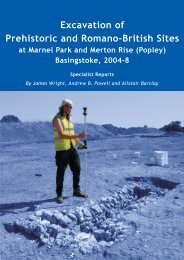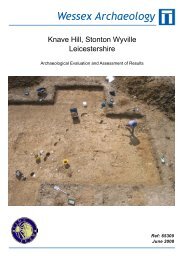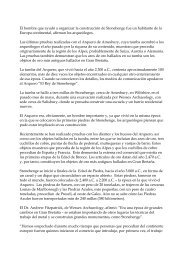Knave Hill, Stonton Wyville, Leicestershire - Wessex Archaeology
Knave Hill, Stonton Wyville, Leicestershire - Wessex Archaeology
Knave Hill, Stonton Wyville, Leicestershire - Wessex Archaeology
You also want an ePaper? Increase the reach of your titles
YUMPU automatically turns print PDFs into web optimized ePapers that Google loves.
Trench 1 (Figures 3-5)4.3.3 Trench 1 was positioned on the ‘D’-shaped enclosure ditch identified by thegeophysical survey. Stripping revealed a large number of postholes in thenorthern end of the trench beyond the potential enclosure. Further southwithin the enclosed area ditches, gullies and pits were also encountered.4.3.4 Ditch (126), a south-west – north-east aligned linear, corresponded with theenclosure boundary as located by the geophysical survey. The dating materialwithin it (all from secondary fill 127) was a mixture of Late Iron Age andRomano-British pottery; four small sherds in sandy fabrics are currentlyundated and could be Anglo-Saxon, but at present this feature is dated asRomano-British. Although fairly wide the feature was relatively shallowrather than a substantial boundary ditch, and the slightly deeper extension ofthe trench to the east removed all traces of it. Slightly to the south-east but atright angles to it was another ditch (199); this was also seen on thegeophysical survey and appears to be an internal division within theenclosure.4.3.5 A large number of possible postholes were also discovered tot he north of theenclosure ditch. Although many proved to be shallow and diffuse severalwere more substantial, with more distinct edges and a steeper profile (Figure4). Six of the features appeared to be definite postholes - (110), (114), (120),(1013) and the intercutting postholes (1003) and (1005). In addition (108),(182), (188) and (1011) may also be true post holes as they are fairly distinct.Saxon pottery was recovered from these features. In total these features forma definite north-west – south-east aligned posthole alignment and also apossible north-east – south-west alignment forming a return. Thesealignments have been provisionally identified as representing a Saxon postbuilthall (Structure 1), at least 10m long and 4m wide.4.3.6 Four other possible postholes were found within the area defined by the D-shaped enclosure. Postholes (160), (162), (164) and (170) form a north-east –south-west line on the same alignment as ditch (126). Another isolatedpossible posthole (156) was found just to the south-east of (126). Otherfeatures in this area are likely to be the result of root disturbance.4.3.7 Two features containing burnt material were also found within the enclosure,(146) and (154) (Figure 5, Plate 3). Both seem to represent the dumping ofhearth material rather than in situ burning.4.3.8 At the far southern end of the trench a pit (150) was discovered (Figure 5,Plate 4). It had a flat base with a number of distinct indentations. There werealso indications of in situ burning. It was suggested that this could have beena clamp kiln, a simple pit for firing pottery, and that the indentations couldhave supported a raised platform, thereby creating an updraft. Very few pitclamps of late Iron Age and Romano-British date have been identified inBritain and those that are known generally contained significant ashydeposits and large numbers of pottery sherds (Swan 1984, 54). Only a littlepottery was recovered from the feature and these sherds showed no evidenceof ‘wasters’. Moreover, the deposits within the feature contained nosignificant amounts of ash or charcoal. It may be that this feature was a6





